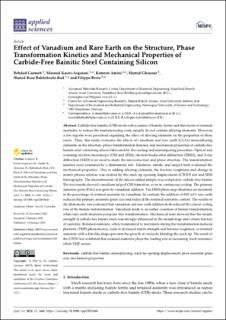| dc.contributor.author | Garmeh, Behdad | |
| dc.contributor.author | Kasiri-Asgarani, Masoud | |
| dc.contributor.author | Amini, Kamran | |
| dc.contributor.author | Ghayour, Hamid | |
| dc.contributor.author | Bakhsheshi-Rad, Hamid Reza | |
| dc.contributor.author | Berto, Filippo | |
| dc.date.accessioned | 2023-02-06T09:52:01Z | |
| dc.date.available | 2023-02-06T09:52:01Z | |
| dc.date.created | 2022-04-27T10:45:48Z | |
| dc.date.issued | 2022 | |
| dc.identifier.citation | Applied Sciences. 2022, 12 (3), . | en_US |
| dc.identifier.issn | 2076-3417 | |
| dc.identifier.uri | https://hdl.handle.net/11250/3048495 | |
| dc.description.abstract | Carbide-free bainitic (CFB) steels with a matrix of bainitic ferrite and thin layers of retained austenite, to reduce the manufacturing costs, usually do not contain alloying elements. However, a few reports were presented regarding the effect of alloying elements on the properties of these steels. Thus, this study evaluates the effects of vanadium and rare earth (Ce-La) microalloying elements on the structure, phase transformation kinetics, and mechanical properties of carbide-free bainite steel containing silicon fabricated by the casting and austempering procedure. Optical and scanning electron microscopy (OM and SEM), electron backscatter diffraction (EBSD), and X-ray diffraction (XRD) were used to study the microstructure and phase structure. The transformation kinetics were examined by a dilatometry test. Hardness, tensile, and impact tests evaluated the mechanical properties. Due to adding alloying elements, the fracture toughness and change in matrix phases relation was studied by the crack tip opening displacement (CTOD) test and SEM fractography. The microstructure of the silicon added sample was completely carbide-free bainite. The test results showed vanadium helped CFB formation, even in continuous cooling. The primary austenite grain (PAG) size grew by vanadium addition. The EBSD phase map illustrates an increment in the percentage of retained austenite by vanadium. In contrast, the addition of 0.03 wt% rare earth reduced the primary austenite grain size and reduced the retained austenite content. The results of the dilatometry test confirmed that vanadium and rare earth addition both reduced the critical cooling rate of the bainite transformation. Vanadium leads to an earlier cessation of bainite transformation, while rare earth elements postpone this transformation. Mechanical tests showed that the tensile strength of carbide-free bainite steels was strongly influenced by the morphology and volume fraction of austenite. Retained austenite, when transformed to martensite during the transformation-induced plasticity (TRIP) phenomenon, leads to increased tensile strength and fracture toughness, or retained austenite with a film-like shape prevents the growth of cracks by blinding the crack tip. The result of the CTOD test exhibited that retained austenite plays the leading role in increasing crack resistance when TRIP occurs. | en_US |
| dc.language.iso | eng | en_US |
| dc.publisher | MDPI | en_US |
| dc.rights | Navngivelse 4.0 Internasjonal | * |
| dc.rights.uri | http://creativecommons.org/licenses/by/4.0/deed.no | * |
| dc.title | Effect of Vanadium and Rare Earth on the Structure, Phase Transformation Kinetics and Mechanical Properties of Carbide-Free Bainitic Steel Containing Silicon | en_US |
| dc.title.alternative | Effect of Vanadium and Rare Earth on the Structure, Phase Transformation Kinetics and Mechanical Properties of Carbide-Free Bainitic Steel Containing Silicon | en_US |
| dc.type | Peer reviewed | en_US |
| dc.type | Journal article | en_US |
| dc.description.version | publishedVersion | en_US |
| dc.source.volume | 12 | en_US |
| dc.source.journal | Applied Sciences | en_US |
| dc.source.issue | 3 | en_US |
| dc.identifier.doi | 10.3390/app12031668 | |
| dc.identifier.cristin | 2019394 | |
| cristin.ispublished | true | |
| cristin.fulltext | original | |
| cristin.qualitycode | 1 | |

